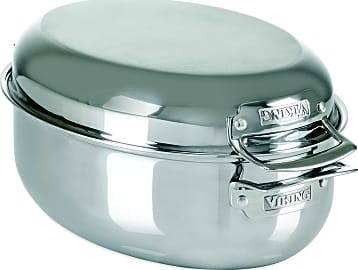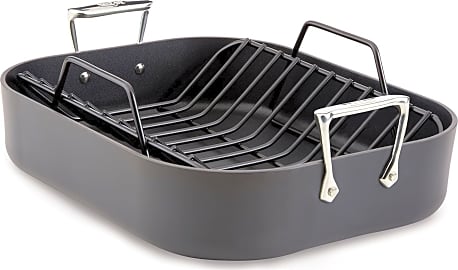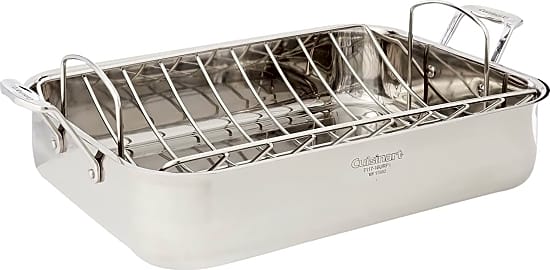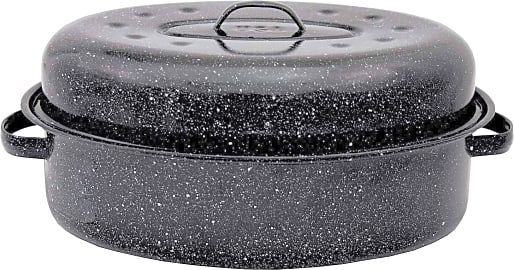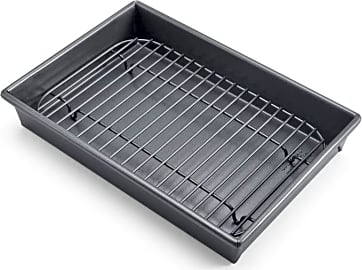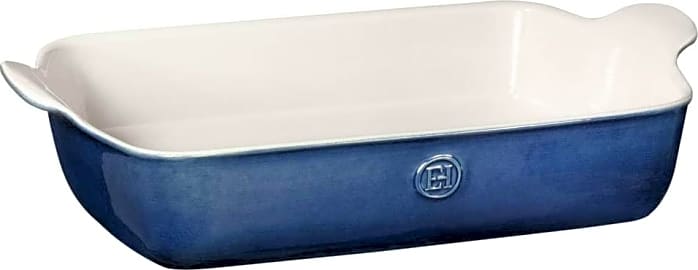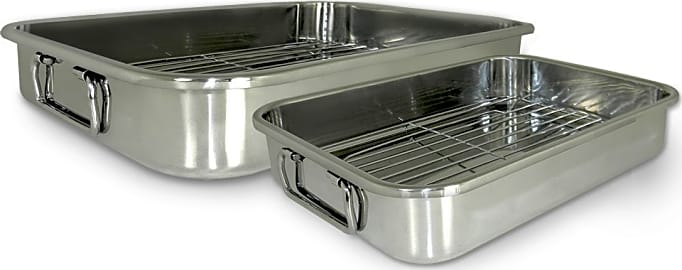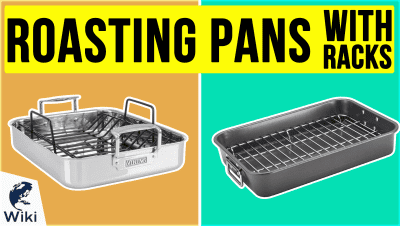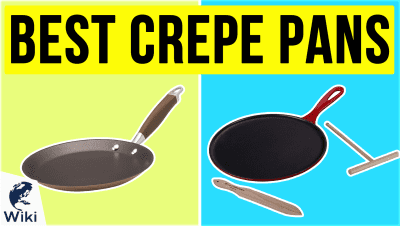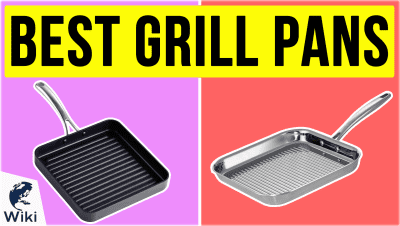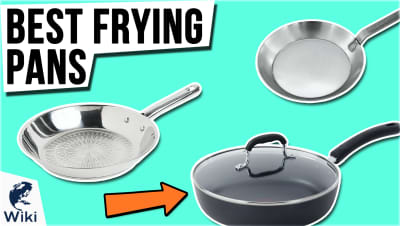The 9 Best Roasting Pans

This wiki has been updated 43 times since it was first published in June of 2015. If you and your dinner guests enjoy a full bird or large joints of meat, your kitchen needs a quality roasting pan. Our selection includes some so easy to clean and chef-friendly that you won't want to wait until the holidays roll around to use them. We've offered a variety of materials and price points for every cook, from novice to pro, so you can find the perfect one for your family. When users buy our independently chosen editorial choices, we may earn commissions to help fund the Wiki.
Editor's Notes
April 22, 2021:
Longtime favorites Granite Ware Covered Oval and Le Creuset Signature remain excellent affordable and ultra-premium options, respectively. Between the cost of those two are the stainless-steel Cuisinart Multi-Clad Pro and the nonstick All-Clad Anodized. The Cuisinart looks a little better and has slightly better heat retention, while the All-Clad is a bit easier to clean.
Outside of our previous #1 option being taken off the market, though, there aren't many changes here. We did add the Cuisinart 7117, which doesn't have quite the premium build of some, but still works just fine for most uses and doesn't cost nearly as much as most high-end options.
March 30, 2020:
While cladded stainless remains a top choice for all types of cookware, for this update we chose to evaluate a wider variety of materials for those who don't mind the heft of cast iron or the extra care needed when dealing with ceramic or anondized aluminum.
The All-Clad Anodized is a serious piece that can handle the largest roasts or poultry. It's great for cooks who prefer the ease of non-stick cookware and don't mind taking care to use plastic utensils to preserve the finish. Anodized aluminum is also significantly harder than stainless steel, so it's nearly impossible to warp.
If you've got the muscles to lift it, cast iron is prized by cooks for consistent, even heating at high or low temperatures. We chose Le Creuset Signature, an enameled model so you get the great performance and as well as quick clean-up.
Nothing beats placing a piping hot dish at the center of the table, and the Emile Henry Modern Classics is attractive enough to even grace the holiday table. Ceramic also heats as evenly as cast iron, and although it's not unbreakable, Emile Henry ceramics are treated with an extra hard glaze to prevent chips and cracks. With normal use and care this piece will last for years.
Special Honors
All Clad Flared Developed in partnership with Williams Sonoma and the top quality All Clad brand, the primary design tweak on this model is the low flared sides for even cooking and better browning all around. The extra-large size can easily hold a 25 pound turkey. williams-sonoma.com
What Makes A Roasting Pan Unique
Another special use of the roasting pan is creating a water bath.
A roasting pan is, first and foremost, made to go in the oven rather than just on a stovetop. So it is made from materials that are oven-safe like clay, which is ideal for browning food, cast-iron, which is a wonderful conductor of heat, stainless steel, and non-stick coated enamel. These can all be subjected to high temperatures for prolonged periods of time, without leaking into the food or posing a fire hazard. Oven baking is, overall, less hazardous than stovetop baking, with the latter being a major cause of fires and burns.
Roasting pans are also much deeper than other types of pans because they’re designed so that a rack can sit on the top, with plenty of room below. You can place meat on the rack, and let the fats and juices fall down to the pan beneath. Having the juices trapped under your meat will keep it moist. Roasting pans are also deep to give one the option of skipping the rack, and simply laying their meat over layers of vegetables. This method lets the juice from the meat marinate the vegetables. Roasting pans are not only deep, but they’re also wide and long because they need to hold large poultry like turkey and entire roasts.
Another special use of the roasting pan is creating a water bath. Some more complex recipes like custard require very specific cooking conditions; they usually need constant moisture while inside the oven and also cannot handle the direct heat of the actual oven. For this, one makes a water bath, which is essentially a large basin in which the small custard dishes sit, surrounded by water, in the oven. A roasting pan is the perfect tool for this.
Understanding Roasting Techniques
There are several ways you can cook food in an oven and they make a big difference in the flavor and consistency of your food. A baked chicken will come out quite different from a roasted one. While baking and roasting both use dry heat to cook food, that’s almost all they have in common. When you roast food, you want the end result to have a brown, flavorful crust. In order to achieve this, you need a higher temperature than you would for baking, and you must brush the outside of your food with some sort of fat, like olive oil.
While baking and roasting both use dry heat to cook food, that’s almost all they have in common.
Baked foods usually call for lower temperatures than roasted ones. Baking is more commonly used for foods that are not solid on the inside to begin with — like cake or muffins — but will harden while they cook. Baked goods go through complex processes that turn them from batter to something edible. Roasting is best for foods that start with a solid interior, like a thick post roast or a whole turkey.
Broiling is best for thin cuts of meat; using this method on thicker cuts can result in risky undercooked meat. This technique utilizes very high temperatures in the oven, but for only a short period of time. When one sets their oven to broil, it sends heat into the food from above it. This both sears and cooks the food at the same time. One can look at broiling like reverse grilling because it directs heat from above rather than below the food.
Why Roasting Your Food Is Easier
The various cooking methods you can use to make your food not only affect the flavor of your ingredients, but also their nutritional content. Roasting food, for starters, does not call for as much calorie-dense oil and fats as other foods. You typically just brush a small amount of oil on the outside of your food to begin the baking process, rather than smothering your food in oil the way one does with frying or sauteing. It is still important to know which fats are best for each cooking method — rapeseed oil is best for roasting — or you can end up with overly greasy baked food.
A final unexpected benefit of any sort of oven baking is the simple time one must put into it.
Roasting your vegetables actually increases their bioavailability, which means your body can better utilize their vitamins and other nutrients. Roasting is also a much healthier means of preparing vegetables than boiling, which can deplete the food of water-soluble vitamins.
Roasting is certainly healthier than one of the more popular cooking methods today, that of deep-frying food. The extremely high temperatures required to deep fry foods causes the ingredients to release a compound called advanced glycation end products, which can lead to carcinogens in your food. Not to mention that baked foods are always lower in calories and fat content than the fried version of the same food.
A final unexpected benefit of any sort of oven baking is the simple time one must put into it. Studies have found that the more time a person spends on making their food, the more conscious they are of what they eat and how much they eat. That awareness is not as high when deep frying or microwaving food.


